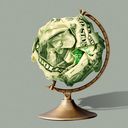The dollar's decline could add huge challenges to the recovery of some economies

Even after sinking by 13% since its March peak and coming off its worst week in a month, the dollar's downward spiral has gone largely unmentioned by central banks. But that could change as the values of many major currencies have strengthened to their highest levels in years against the greenback.
Why it matters: The dollar's decline could add significant challenges to the recovery of export-oriented economies like the eurozone and Japan, which prefer weaker currencies that make their products more attractive to foreign buyers.
- And while the dollar's dive has helped rally stocks in emerging countries, those that are dependent on exports could see a slowdown in their growth because of their newly strong currencies.
By the numbers: The dollar is near its weakest level in over a year against at least 17 currencies, according to calculations from Deutsche Bank, including eight of the G10 currencies.
- The Taiwan dollar and Israeli shekel recently hit their strongest levels against the dollar in more than 23 years and 12 years, respectively.
The big picture: Like the rally in equity markets, the bottom falling out on the dollar looks to be based on exuberance about the development of COVID-19 vaccines leading to stronger economic growth globally in 2021. (And of course the market backstop from the Fed in the form of unprecedented bond buying and negative real interest rates.)
- But Juan Perez, senior FX trader and strategist at Tempus Inc, tells Axios in an email that he worries the weak dollar trade already may be "a bit overdone" as markets are looking past significant risks, including possible hiccups in the development and rollout of the vaccines, a hard Brexit and continued anxiety in Europe.
- "So many risk items to watch, it’ll make ya head spin."
The state of play: Asset managers have built record short positions against the dollar, Bloomberg reported, citing CFTC data from the week ending Nov. 24. Bloomberg also notes...
- Credit Suisse has forecast the euro will rise to $1.25 by the end of 2021.
- Goldman Sachs Asset Management has called for shorting the dollar against the Chinese yuan along with further gains in the euro and yen.
- Morgan Stanley and Citigroup have both recently forecast a weaker greenback.
The last word: "What breaks this chain?" asks Deutsche Bank macro strategist Alan Ruskin.
- "Usually it has to come from US fundamentals, although in the current instance, it likely needs some break to the extraordinary risk positive momentum, if not from news flow, then via evidence that risk is overpositioned and bellwethers like the S&P are no longer responding to good news."